Amanda Prorok
University of Cambridge
Remotely Detectable Robot Policy Watermarking
Dec 17, 2025Abstract:The success of machine learning for real-world robotic systems has created a new form of intellectual property: the trained policy. This raises a critical need for novel methods that verify ownership and detect unauthorized, possibly unsafe misuse. While watermarking is established in other domains, physical policies present a unique challenge: remote detection. Existing methods assume access to the robot's internal state, but auditors are often limited to external observations (e.g., video footage). This ``Physical Observation Gap'' means the watermark must be detected from signals that are noisy, asynchronous, and filtered by unknown system dynamics. We formalize this challenge using the concept of a \textit{glimpse sequence}, and introduce Colored Noise Coherency (CoNoCo), the first watermarking strategy designed for remote detection. CoNoCo embeds a spectral signal into the robot's motions by leveraging the policy's inherent stochasticity. To show it does not degrade performance, we prove CoNoCo preserves the marginal action distribution. Our experiments demonstrate strong, robust detection across various remote modalities, including motion capture and side-way/top-down video footage, in both simulated and real-world robot experiments. This work provides a necessary step toward protecting intellectual property in robotics, offering the first method for validating the provenance of physical policies non-invasively, using purely remote observations.
No-Regret Thompson Sampling for Finite-Horizon Markov Decision Processes with Gaussian Processes
Oct 23, 2025Abstract:Thompson sampling (TS) is a powerful and widely used strategy for sequential decision-making, with applications ranging from Bayesian optimization to reinforcement learning (RL). Despite its success, the theoretical foundations of TS remain limited, particularly in settings with complex temporal structure such as RL. We address this gap by establishing no-regret guarantees for TS using models with Gaussian marginal distributions. Specifically, we consider TS in episodic RL with joint Gaussian process (GP) priors over rewards and transitions. We prove a regret bound of $\mathcal{\tilde{O}}(\sqrt{KH\Gamma(KH)})$ over $K$ episodes of horizon $H$, where $\Gamma(\cdot)$ captures the complexity of the GP model. Our analysis addresses several challenges, including the non-Gaussian nature of value functions and the recursive structure of Bellman updates, and extends classical tools such as the elliptical potential lemma to multi-output settings. This work advances the understanding of TS in RL and highlights how structural assumptions and model uncertainty shape its performance in finite-horizon Markov Decision Processes.
LF: Online Multi-Robot Path Planning Meets Optimal Trajectory Control
Jul 15, 2025Abstract:We propose a multi-robot control paradigm to solve point-to-point navigation tasks for a team of holonomic robots with access to the full environment information. The framework invokes two processes asynchronously at high frequency: (i) a centralized, discrete, and full-horizon planner for computing collision- and deadlock-free paths rapidly, leveraging recent advances in multi-agent pathfinding (MAPF), and (ii) dynamics-aware, robot-wise optimal trajectory controllers that ensure all robots independently follow their assigned paths reliably. This hierarchical shift in planning representation from (i) discrete and coupled to (ii) continuous and decoupled domains enables the framework to maintain long-term scalable motion synthesis. As an instantiation of this idea, we present LF, which combines a fast state-of-the-art MAPF solver (LaCAM), and a robust feedback control stack (Freyja) for executing agile robot maneuvers. LF provides a robust and versatile mechanism for lifelong multi-robot navigation even under asynchronous and partial goal updates, and adapts to dynamic workspaces simply by quick replanning. We present various multirotor and ground robot demonstrations, including the deployment of 15 real multirotors with random, consecutive target updates while a person walks through the operational workspace.
When Is Diversity Rewarded in Cooperative Multi-Agent Learning?
Jun 11, 2025Abstract:The success of teams in robotics, nature, and society often depends on the division of labor among diverse specialists; however, a principled explanation for when such diversity surpasses a homogeneous team is still missing. Focusing on multi-agent task allocation problems, our goal is to study this question from the perspective of reward design: what kinds of objectives are best suited for heterogeneous teams? We first consider an instantaneous, non-spatial setting where the global reward is built by two generalized aggregation operators: an inner operator that maps the $N$ agents' effort allocations on individual tasks to a task score, and an outer operator that merges the $M$ task scores into the global team reward. We prove that the curvature of these operators determines whether heterogeneity can increase reward, and that for broad reward families this collapses to a simple convexity test. Next, we ask what incentivizes heterogeneity to emerge when embodied, time-extended agents must learn an effort allocation policy. To study heterogeneity in such settings, we use multi-agent reinforcement learning (MARL) as our computational paradigm, and introduce Heterogeneous Environment Design (HED), a gradient-based algorithm that optimizes the parameter space of underspecified MARL environments to find scenarios where heterogeneity is advantageous. Experiments in matrix games and an embodied Multi-Goal-Capture environment show that, despite the difference in settings, HED rediscovers the reward regimes predicted by our theory to maximize the advantage of heterogeneity, both validating HED and connecting our theoretical insights to reward design in MARL. Together, these results help us understand when behavioral diversity delivers a measurable benefit.
D4orm: Multi-Robot Trajectories with Dynamics-aware Diffusion Denoised Deformations
Mar 15, 2025Abstract:This work presents an optimization method for generating kinodynamically feasible and collision-free multi-robot trajectories that exploits an incremental denoising scheme in diffusion models. Our key insight is that high-quality trajectories can be discovered merely by denoising noisy trajectories sampled from a distribution. This approach has no learning component, relying instead on only two ingredients: a dynamical model of the robots to obtain feasible trajectories via rollout, and a score function to guide denoising with Monte Carlo gradient approximation. The proposed framework iteratively optimizes the deformation from the previous round with this denoising process, allows \textit{anytime} refinement as time permits, supports different dynamics, and benefits from GPU acceleration. Our evaluations for differential-drive and holonomic teams with up to 16 robots in 2D and 3D worlds show its ability to discover high-quality solutions faster than other black-box optimization methods such as MPPI, approximately three times faster in a 3D holonomic case with 16 robots. As evidence for feasibility, we demonstrate zero-shot deployment of the planned trajectories on eight multirotors.
DVM-SLAM: Decentralized Visual Monocular Simultaneous Localization and Mapping for Multi-Agent Systems
Mar 06, 2025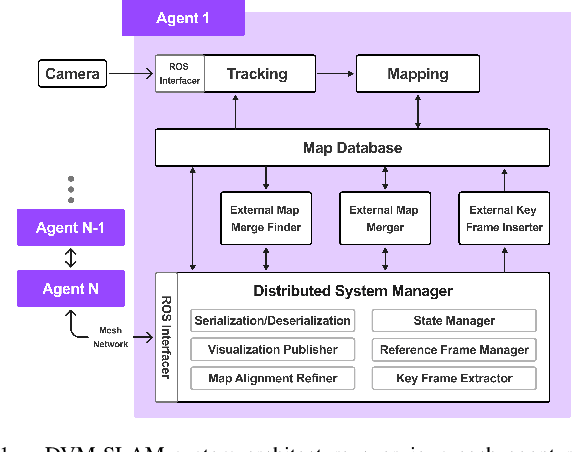

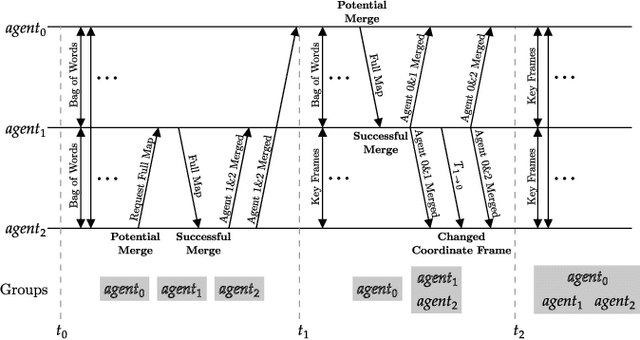
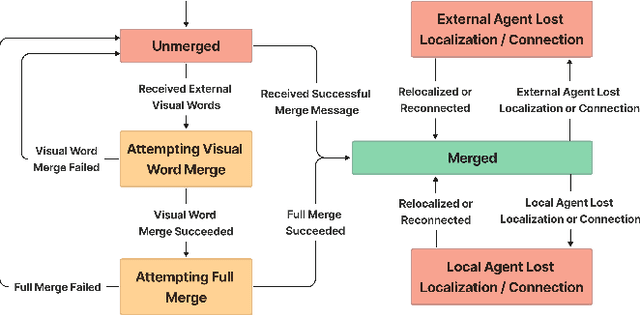
Abstract:Cooperative Simultaneous Localization and Mapping (C-SLAM) enables multiple agents to work together in mapping unknown environments while simultaneously estimating their own positions. This approach enhances robustness, scalability, and accuracy by sharing information between agents, reducing drift, and enabling collective exploration of larger areas. In this paper, we present Decentralized Visual Monocular SLAM (DVM-SLAM), the first open-source decentralized monocular C-SLAM system. By only utilizing low-cost and light-weight monocular vision sensors, our system is well suited for small robots and micro aerial vehicles (MAVs). DVM-SLAM's real-world applicability is validated on physical robots with a custom collision avoidance framework, showcasing its potential in real-time multi-agent autonomous navigation scenarios. We also demonstrate comparable accuracy to state-of-the-art centralized monocular C-SLAM systems. We open-source our code and provide supplementary material online.
Distributed Coverage Control for Time-Varying Spatial Processes
Feb 11, 2025Abstract:Multi-robot systems are essential for environmental monitoring, particularly for tracking spatial phenomena like pollution, soil minerals, and water salinity, and more. This study addresses the challenge of deploying a multi-robot team for optimal coverage in environments where the density distribution, describing areas of interest, is unknown and changes over time. We propose a fully distributed control strategy that uses Gaussian Processes (GPs) to model the spatial field and balance the trade-off between learning the field and optimally covering it. Unlike existing approaches, we address a more realistic scenario by handling time-varying spatial fields, where the exploration-exploitation trade-off is dynamically adjusted over time. Each robot operates locally, using only its own collected data and the information shared by the neighboring robots. To address the computational limits of GPs, the algorithm efficiently manages the volume of data by selecting only the most relevant samples for the process estimation. The performance of the proposed algorithm is evaluated through several simulations and experiments, incorporating real-world data phenomena to validate its effectiveness.
Neural diversity is key to collective artificial learning
Dec 19, 2024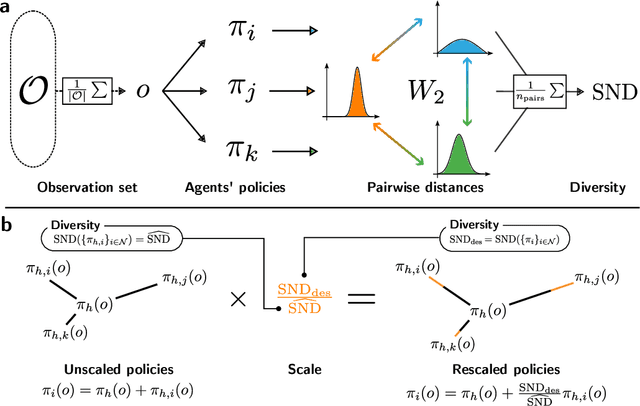

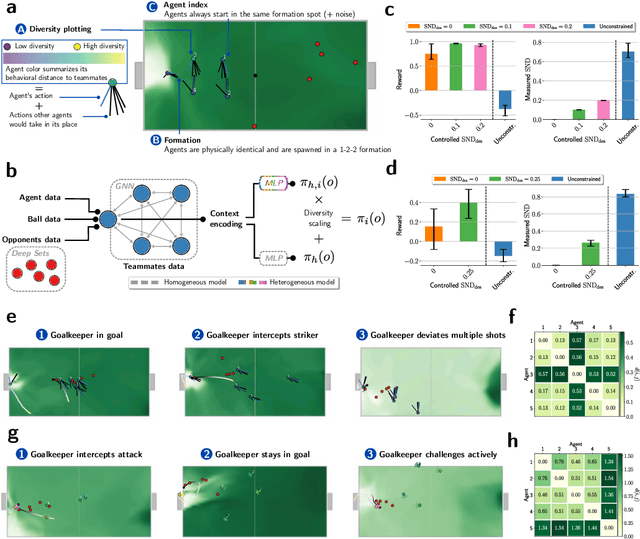
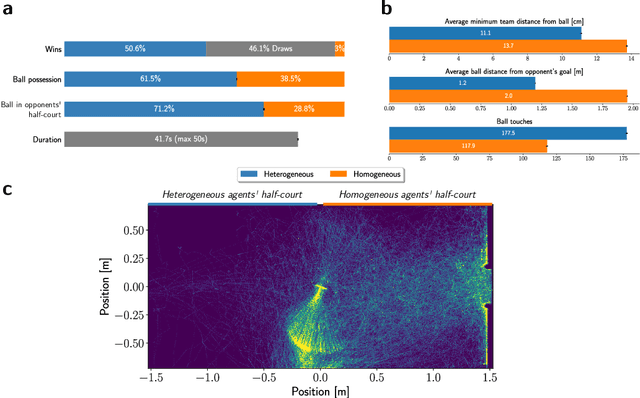
Abstract:Many of the world's most pressing issues, such as climate change and global peace, require complex collective problem-solving skills. Recent studies indicate that diversity in individuals' behaviors is key to developing such skills and increasing collective performance. Yet behavioral diversity in collective artificial learning is understudied, with today's machine learning paradigms commonly favoring homogeneous agent strategies over heterogeneous ones, mainly due to computational considerations. In this work, we employ novel diversity measurement and control paradigms to study the impact of behavioral heterogeneity in several facets of collective artificial learning. Through experiments in team play and other cooperative tasks, we show the emergence of unbiased behavioral roles that improve team outcomes; how neural diversity synergizes with morphological diversity; how diverse agents are more effective at finding cooperative solutions in sparse reward settings; and how behaviorally heterogeneous teams learn and retain latent skills to overcome repeated disruptions. Overall, our results indicate that, by controlling diversity, we can obtain non-trivial benefits over homogeneous training paradigms, demonstrating that diversity is a fundamental component of collective artificial learning, an insight thus far overlooked.
A Survey on Small-Scale Testbeds for Connected and Automated Vehicles and Robot Swarms
Aug 26, 2024



Abstract:Connected and automated vehicles and robot swarms hold transformative potential for enhancing safety, efficiency, and sustainability in the transportation and manufacturing sectors. Extensive testing and validation of these technologies is crucial for their deployment in the real world. While simulations are essential for initial testing, they often have limitations in capturing the complex dynamics of real-world interactions. This limitation underscores the importance of small-scale testbeds. These testbeds provide a realistic, cost-effective, and controlled environment for testing and validating algorithms, acting as an essential intermediary between simulation and full-scale experiments. This work serves to facilitate researchers' efforts in identifying existing small-scale testbeds suitable for their experiments and provide insights for those who want to build their own. In addition, it delivers a comprehensive survey of the current landscape of these testbeds. We derive 62 characteristics of testbeds based on the well-known sense-plan-act paradigm and offer an online table comparing 22 small-scale testbeds based on these characteristics. The online table is hosted on our designated public webpage www.cpm-remote.de/testbeds, and we invite testbed creators and developers to contribute to it. We closely examine nine testbeds in this paper, demonstrating how the derived characteristics can be used to present testbeds. Furthermore, we discuss three ongoing challenges concerning small-scale testbeds that we identified, i.e., small-scale to full-scale transition, sustainability, and power and resource management.
Language-Conditioned Offline RL for Multi-Robot Navigation
Jul 29, 2024Abstract:We present a method for developing navigation policies for multi-robot teams that interpret and follow natural language instructions. We condition these policies on embeddings from pretrained Large Language Models (LLMs), and train them via offline reinforcement learning with as little as 20 minutes of randomly-collected data. Experiments on a team of five real robots show that these policies generalize well to unseen commands, indicating an understanding of the LLM latent space. Our method requires no simulators or environment models, and produces low-latency control policies that can be deployed directly to real robots without finetuning. We provide videos of our experiments at https://sites.google.com/view/llm-marl.
 Add to Chrome
Add to Chrome Add to Firefox
Add to Firefox Add to Edge
Add to Edge